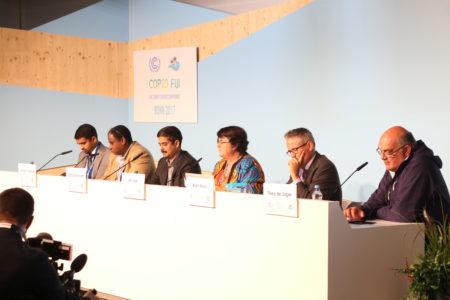Experts explore the land and water advantage challenges around small-scale farming systems in Asia and Africa.

On the sidelines of COP23, a side event with nearly 100 attendees explored land and water solutions, and how these will drive adaptation in agriculture, citing examples from Africa and Asia. The session was part of the Agriculture Advantage series and it was organized by the International Potato Center (CIP) in close collaboration with the CGIAR Research Programs on Climate Change, Agriculture and Food Security (CCAFS), CGIAR Research Program on Roots, Tubers and Bananas (RTB) and the International Water Management Institute (IWMI).
Highlighting work by CIP in sub-Saharan Africa, Jan Low noted that tackling climate change meant producing more adapted crops faster and under tougher conditions and with less water while addressing nutrition.
“At CIP, our breeding work is not just about yield, pest and disease tolerance, it’s also about quality especially for women and children,” she said.
In Mozambique alone, 19 drought tolerant pro-vitamin A rich orange-fleshed sweetpotato (OFSP) varieties have been released. Vitamin A deficiency is a serious problem among children under five in sub-Saharan Africa. In the region, sweet potato is leading in terms of area expansion because of high energy output per unit area per unit time.
In the context of root and tuber crops, no one solution fits all crops in terms of tackling emerging diseases and pests. “Whereas conventional breeding appears to work in tacking the sweetpotato virus, the potato late blight disease continues to be a problem. Researchers are however making progress through biotechnology in tackling potato late blight,” she said.
View Jan’s presentation on slideshare: can non-GMO climate-smart crops alone sustain small-scale farming?
By 2050, global food production must increase by 60%. Innovations for water management are essential in achieving this, Alan Nicol from IWMI highlighted. “For smallholder farming, managing agricultural water availability, access and use is key to success,” he noted. He shared case studies, including solar energy to strengthen access to water for agriculture, increasing availability via rainwater harvesting, improving usage via the wetting front technology, and understanding scale for food security monitoring and hazard risk mapping, as well as index-based flood insurance.
When it comes to water management, “it’s really about blending water-smart agricultural techniques and approaches, but also social and institutional environments in which they exist, into climate-smart agriculture,” he said.
Theo de Jager, president of the the WFO gave the farmer perspective reiterating the importance of land and water for agriculture. He noted that unlocking the wealth in land and water required investments yet the world’s poorest farmers in the world cannot access financing.
“There are smart ways of using water and land because of new technologies – but they cost a lot of money,” he noted. Without access to finances, new technologies remain evasive for smallholder farmers. Yet with climate change, farmers cannot continue with the business as usual approach.
“Many are caught up in a poverty trap; there’s no new technology, nothing has evolved. Irrigation, if there is any, is only flood irrigation,” he added. Smallholder farmer productivity is quite low and future farmers cannot continue the same way given scarce water and land resources. De Jager called for better support and investments to ensure sustainable land and water use by farmers.
In response to Theo’s call, James Kinyangi from the African Development Bank (AFDB) highlighted how the bank was building a supporting enabling environment in Africa for agricultural transformation. “We are working on seven enablers to support agricultural growth, productivity and value addition,” he noted. These include: increase productivity; value addition; hard and soft infrastructure; agricultural finance; agribusiness environment; inclusivity sustainability and nutrition; and coordination. Also, he highlighted work on risk management, asset protection and inclusion of women and youth as being crucial in providing a supporting enabling environment.
Kinyangi further highlighted various platforms and partnerships for mobilizing agricultural finance. These are: development finance institutions; AfDB country offices and local banks; co-development partners such as research institutions, policy and investor platforms; small and large scale agribusinesses, farmer organizations and food companies; investment funds; and donors, foundations and government organizations.
At the end of the event, Dhanush Dinesh from CCAFS reflected on the question: Is sustainable land and water management compatible with small scale farming under climate change? “If we work on these factors appropriately, it is possible to be a yes,” he said. Such factors, as highlighted by various speakers included: having investments at different scales, in context and holistic models; leap frogging using data, science and research; social inclusion with a focus on women as well as youth who are farmers of the future, and building partnerships at scale very quickly.
Blog written by Vivian Atakos (CIP) and Lili Szilagyi (CCAFS)
